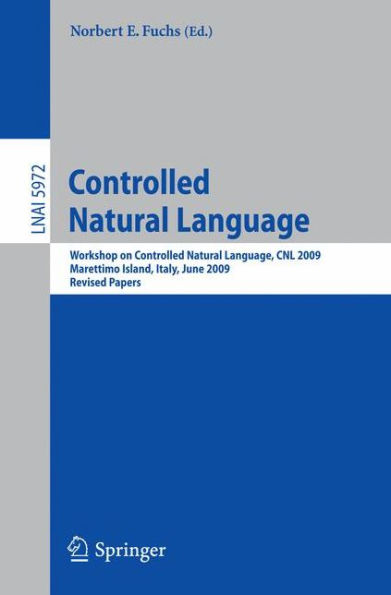Controlled Natural Language: Workshop on Controlled Natural Language, CNL 2009, Marettimo Island, Italy, June 8-10, 2009, Revised Papers
Controlled natural languages (CNLs) are subsets of natural languages, obtained by - stricting the grammar and vocabulary in order to reduce or eliminate ambiguity and complexity. Traditionally, controlled languagesfall into two major types: those that - prove readability for human readers, and those that enable reliable automatic semantic analysis of the language. [. . . ] The second type of languages has a formal logical basis, i. e. they have a formal syntax and semantics, and can be mapped to an existing formal language, such as first-order logic. Thus, those languages can be used as knowledge representation languages, and writing of those languages is supported by fully au- matic consistency and redundancy checks, query answering, etc. Wikipedia Variouscontrollednatural languagesof the second type have been developedby a n- ber of organizations, and have been used in many different application domains, most recently within the Semantic Web. The workshop CNL 2009 was dedicated to discussing the similarities and the d- ferences of existing controlled natural languages of the second type, possible impro- ments to these languages, relations to other knowledge representation languages, tool support, existing and future applications, and further topics of interest.
1111360815
Controlled Natural Language: Workshop on Controlled Natural Language, CNL 2009, Marettimo Island, Italy, June 8-10, 2009, Revised Papers
Controlled natural languages (CNLs) are subsets of natural languages, obtained by - stricting the grammar and vocabulary in order to reduce or eliminate ambiguity and complexity. Traditionally, controlled languagesfall into two major types: those that - prove readability for human readers, and those that enable reliable automatic semantic analysis of the language. [. . . ] The second type of languages has a formal logical basis, i. e. they have a formal syntax and semantics, and can be mapped to an existing formal language, such as first-order logic. Thus, those languages can be used as knowledge representation languages, and writing of those languages is supported by fully au- matic consistency and redundancy checks, query answering, etc. Wikipedia Variouscontrollednatural languagesof the second type have been developedby a n- ber of organizations, and have been used in many different application domains, most recently within the Semantic Web. The workshop CNL 2009 was dedicated to discussing the similarities and the d- ferences of existing controlled natural languages of the second type, possible impro- ments to these languages, relations to other knowledge representation languages, tool support, existing and future applications, and further topics of interest.
54.99
In Stock
5
1

Controlled Natural Language: Workshop on Controlled Natural Language, CNL 2009, Marettimo Island, Italy, June 8-10, 2009, Revised Papers
291
Controlled Natural Language: Workshop on Controlled Natural Language, CNL 2009, Marettimo Island, Italy, June 8-10, 2009, Revised Papers
291Paperback(2010)
$54.99
54.99
In Stock

Product Details
| ISBN-13: | 9783642144172 |
|---|---|
| Publisher: | Springer Berlin Heidelberg |
| Publication date: | 09/08/2010 |
| Series: | Lecture Notes in Computer Science , #5972 |
| Edition description: | 2010 |
| Pages: | 291 |
| Product dimensions: | 6.10(w) x 9.20(h) x 0.60(d) |
From the B&N Reads Blog
